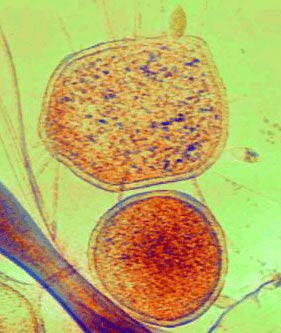Bizarre Super-Small Microbes Discovered

Researchers have discovered some of the tiniest and weirdest microbes ever seen growing in a copper mine sludge that is as acidic as battery acid.
Theses ultra-small microbes were first discovered four years ago, but now scientists have reconstructed their genomes (an organism’s genetic material) and found that they are among the simplest ever described for a living organism.
Named ARMAN, or archaeal Richmond Mine acidophilic nanoorganisms, as a nod to the mine’s owner, Ted Arman, these Archaea (the domain of life that groups together once-celled creatures) are rivaled in size only by a microbe that survives solely as a parasite attached to other cells. ARMAN, however, appears to exist largely as a free-living organism, but oddly, researchers discovered up to ten percent of their specimens impaled on needle-like protuberances originating from another microbe, Thermoplasmatales.
"It is really remarkable and suggests an interaction that has never been described before in nature," said Brett J. Baker of the University of California at Berkeley.
The researchers suspect that the penetrating spines of Thermoplasmatales may mean that the microbes live off other microbes at least part of the time, unlike symbiotic organisms or parasites, which must always associate with other organisms to live.
The research team will combine a 3-D view of this bizarre microbial interaction with molecular tools based upon the sequenced ARMAN genome to gain a better understanding of biofilm communities—groups of microorganisms attached together—that thrive in harsh environments.
Scientists originally thought ARMAN might be a parasite for two reasons: its diminutive size—the microbe is only about 200-400 nanometers, or one-third the size of E. Coli bacteria and appears as a speck of dust under a light microscope—and its compact genome—that is a mere 1 million base pairs, compared to the hundreds of billions of base pairs in humans.
Sign up for the Live Science daily newsletter now
Get the world’s most fascinating discoveries delivered straight to your inbox.
Despite ARMAN's genomic simplicity, as much as 45 percent of its genes are unknown—more than any other organisms sequenced. ARMAN shares many genes with a couple evolutionary branches of Archaea, but also has many not seen in either branch suggesting ARMAN may have been present since the two branches split billions of years ago.
Baker and his team detailed their findings in the April 26 online edition of the journal Proceedings of the National Academy of Sciences.
- 10 Deadly Diseases That Hopped Across Species
- Dangers in the Deep: 10 Scariest Creatures
- Wild Things: The Most Extreme Creatures









